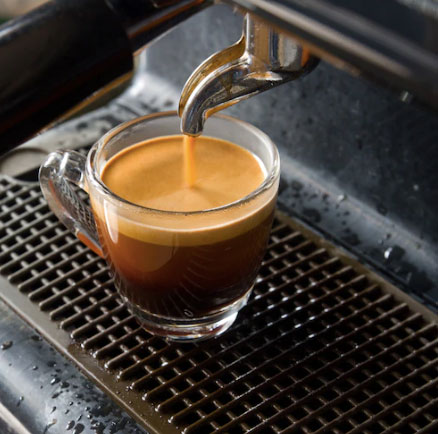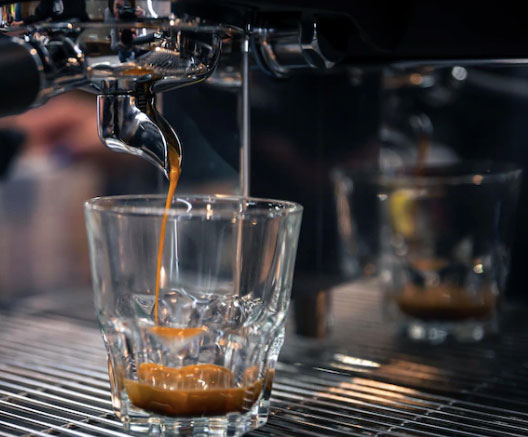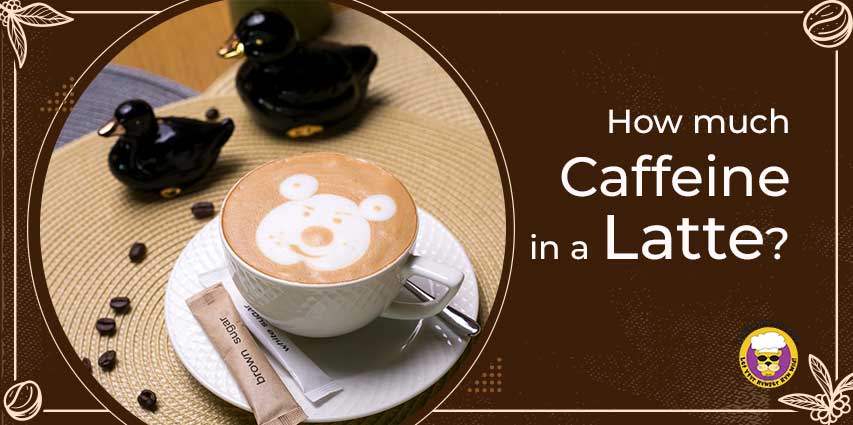If you’ve ever purchased a latte, there’s no doubt that you’ve wondered just How much caffeine in a latte? After all, many of us consume coffee drinks for the energy boost they can provide and understanding what’s actually present in these beverages is an important factor when choosing your morning cup of joe.
In this blog post, we’ll explore the amount of caffeine typically found in a latte and explain why the exact quantity varies. We’ll also discuss some alternatives if you’re looking for more – or less – than what’s usually served up at your favorite café. So grab a mug (or Thermos!) and get ready to find out everything you need to know about lattes and their caffeinated contents!
What is a Latte?
A latte is a coffee drink made with freshly-brewed espresso, steamed milk and usually topped with some foam. It’s one of the most popular beverages in cafes around the world and its creamy texture makes it a great choice for those looking for something more substantial than just a cup of joe.

How Much Caffeine in a Latte?
The amount of caffeine found in a latte can vary quite widely depending on the size and type you choose. Generally, an 8 ounce latte contains around 75 milligrams of caffeine (about the same as what’s present in a single shot of espresso). If you opt for a larger size – such as 12 ounces – expect to consume around 100 milligrams of caffeine.
However, the exact quantity can also depend on other factors such as the type of beans used for the espresso and how much milk you add. For instance, if you opt for a blend that contains more Robusta bean (which is higher in caffeine) then expect your latte to pack an extra punch of energy thanks to a higher caffeine content.

Alternatives to Latte for Caffeine Boost
If you’re looking for an alternative to your usual latte that will give you more of an energy boost then there are some other coffee drinks that could be just what you need. A cappuccino, for example, contains double the amount of espresso – and therefore twice the amount of caffeine – as a standard latte. This can be the perfect pick-me-up if you need an extra jolt in the morning!
Related article:
What is an Americano Coffee?
Best Plumbed Coffee Maker: Top 5 Plumbed Machines 2023
Latte Vs Coffee – which one is better? (4 Key Differences)
Ristretto vs Long Shot: 5 Differences You Need To Know
How many scoops of coffee for 12 cups? A Completely Amazing Guide For You!
What kind of coffee is in a latte?
A latte is typically made with a single shot of espresso, which is brewed by forcing hot water through finely-ground coffee beans. The espresso and steamed milk are then blended together to create the creamy consistency we all know and love.
When choosing what kind of coffee to use in your latte it’s important to pick a blend that’s been roasted and ground specifically for espresso machines. A medium-dark roast will usually result in a smoother, more flavorful latte that offers the perfect balance of sweetness and bitterness.
What’s the Difference between Cappuccino vs. Latte vs. Macchiato?
The biggest difference between cappuccino vs. latte vs. macchiato lies in how much espresso and milk is used for each drink. A cappuccino contains two shots of espresso and a smaller amount of steamed milk, while a latte usually has one shot of espresso with more milk added to it. A macchiato, on the other hand, is made with a single shot of espresso and just a few drops of steamed milk.
This makes it much stronger than both cappuccino and latte. The flavor balance can also be quite different – cappuccinos are generally foamier and sweeter, while macchiatos tend to be more bitter and less creamy.
Does Latte have caffeine?
Yes, lattes do contain caffeine thanks to the espresso used in their preparation. The exact amount of caffeine found in a latte will depend on various factors such as the size of the beverage, the type of beans used for the espresso and how much milk is added. Generally speaking, an 8 ounce latte will contain about 75 milligrams of caffeine, while a larger size (such as 12 ounces) can contain around 100 milligrams.
As mentioned above, the type of beans used will also play an important role in determining how much caffeine is present. If you opt for a blend that contains more Robusta bean then expect your latte to have a higher caffeine content.
How much caffeine in a latte?
The amount of caffeine found in a latte can vary quite widely depending on the size and type you choose. Generally, an 8 ounce latte contains around 75 milligrams of caffeine (about the same as what’s present in a single shot of espresso). If you opt for a larger size – such as 12 ounces – expect to consume around 100 milligrams of caffeine.
However, the exact quantity can also depend on other factors such as the type of beans used for the espresso and how much milk you add. For instance, if you opt for a blend that contains more Robusta bean (which is higher in caffeine) then expect your latte to pack an extra punch of energy thanks to a higher caffeine content.

Factors that Affect Caffeine Content of Latte
There are several factors that can affect the amount of caffeine found in a latte. The size of the beverage will be one factor – a larger drink will contain more caffeine than a smaller one. Additionally, the type of beans used for the espresso can also play an important role; varieties like Robusta bean tend to have a higher caffeine content than Arabica beans.
Finally, the amount of milk added to the drink will impact its caffeine content: adding more milk will result in a lower overall level of caffeine. By understanding these different factors you can customize your latte to suit your individual preference for caffeination levels!
How to Order a Low-Caffeine Latte?
If you are looking for a low-caffeine option without sacrificing flavor, then there are several things that you can do. First, try ordering a smaller size latte – an 8 ounce cup will generally have lower caffeine content than larger sizes. Then, opt for Arabica beans over Robusta beans. Finally, be sure to add more milk to the drink – this will dilute the caffeine content and result in a smoother, less caffeinated beverage. By making these adjustments you can still enjoy all the deliciousness of a latte without the energy boost from high levels of caffeine!
How to Customize Your Latte’s Caffeine Content?
Start by selecting the right size – an 8 ounce cup will generally provide a lower caffeine content, while larger sizes may contain more. Next, choose between Arabica and Robusta beans – Arabica beans tend to have a lower caffeine levelavier milk-to-espresso ratio will also yield a less caffeinated concoction. Finally, experiment with the type of milk you use – whole milk has more caffeine than lower fat options like skim or almond milk. By taking into account these factors, you can tailor your latte to meet your desired level of caffeination!
Decaf or Regular Latte: Which One Should You Choose?
choice between decaf and regular lattes ultimately comes down to personal preference. However, it’s worth mentioning that caffeinated drinks do have their benefits – from providing an energy boost to aiding mental focus during a long day. That said, if you’re trying to limit your caffeine intake or avoid consuming too much of it in one sittingres a good rule of thumb to follow: if you’re having more than two cups in a day, opt for decaf. That way, you can still enjoy the taste of your favorite latte without worrying about consuming too much caffeine.
If you’re looking for an alternative to caffeine-packed drinks, why only try an herbal latte or tea? Herbal drinks can provide a great alternative to coffee and other caffeinated beverages, as they are naturally caffeine-free and loaded with antioxidants. In fact, many herbal drinks such as chai and matcha lattes have gained popularity in recent years due to their delicious flavor profiles and health benefits. So if you’re looking for a lower-caffeine or caffeine-free option, consider giving an herbal latte or tea a try!
Health Benefits of Lattes
Lattes can actually offer some surprising health benefits – particularly if you opt for a low-fat milk variety. For instance, studies have shown that regularly drinking lattes made with skimmed milk may help to reduce the risk of stroke and other cardiovascular diseases.
Additionally, they contain various vitamins and minerals such as calcium and vitamin B2 which can help to strengthen bones and reduce the risk of osteoporosis. Furthermore, caffeinated lattes can also provide a boost of energy – perfect for those days when you’re feeling extra sluggish! All in all, lattes are a delicious and healthy way to get your daily dose of caffeine.
How many lattes can you drink in a day?
The recommended daily caffeine intake for an adult is 400 mg. Depending on the size and type of latte you choose, that could mean up to 4 or 5 lattes per day. However, it’s important to keep in mind that too much caffeine can have a range of negative effects such as insomnia, anxiety and restlessness. For this reason, it’s best to limit your daily latte consumption and opt for other caffeine sources such as green tea or coffee. Remember – everything in moderation!
How Much Caffeine is in a 12 Oz Starbucks Latte?
A 12 oz Starbucks latte usually contains around 95 milligrams of caffeine. However, this can vary depending on the type of beans used for the espresso and how much milk is added. If you opt for a blend that contains more Robusta bean then expect your latte to have a higher caffeine content. Additionally, adding more milk will result in a lower overall level of caffeine. So if you’re looking for an extra energy boost, opt for a smaller size with less milk!
Why is McDonalds coffee so good?
McDonalds coffee is so good because of a few key factors. Firstly, the chain uses high-quality Arabica beans which provide a smooth and rich flavor. Additionally, McDonalds has perfected the art of brewing their coffee – the blend is carefully pre-measured and brewed to precise temperatures in order to ensure an optimal cup every single time. Finally, McDonalds also adds cream and sugar to each cup of coffee, which helps to enhance the flavor even further. All in all, it’s no wonder why so many people love McDonalds coffee!
Ingredient Caffe Latte
A caffe latte typically contains espresso, steamed milk and a small amount of foam. The espresso is made from finely ground coffee beans, usually Arabica beans for a smoother flavor. The steamed milk adds creaminess and sweetness to the drink while the foam helps to create an indulgent texture. Depending on your preference you can also add sugar, syrup or spices such as cinnamon or nutmeg. All in all, a caffe latte is a delicious and indulgent way to enjoy your daily caffeine fix!
Tips For Making Iced Coffee Taste Better:
- Use fresh, high-quality coffee beans – this will ensure a better flavor and richer taste.
- Try using cold brew concentrate instead of regular brewed coffee – this has a much more intense flavor.
- Add some cream or milk to your iced coffee for an extra creamy texture and sweetness.
- Add a few drops of flavored syrup for an extra kick of flavor – anything from caramel to vanilla works great!
- Top your iced coffee off with a dollop of whipped cream and a sprinkle of cinnamon or chocolate shavings.
- Finally, use plenty of ice so that your iced coffee is nice and cold!
Overall, making iced coffee is a great way to cool off in the summer months and still get your daily caffeine fix. With these tips, you can make sure that your iced coffee tastes amazing every time!
Comparing Caffeine in A Latte to Other Coffee Beverages
latte contains less caffeine than most other coffee beverages. An 8 ounce cup of latte, for example, has about 63 milligrams of caffeine – much less than the average cup of brewed coffee or espresso which typically contain over twice as much. Similarly, a small cappuccino (12 ounces) contains about 75 milligrams of caffeineavier milk-based drinks such as a mocha or macchiato contain even more caffeine – around 90 milligrams per 12 ounce cup – while some specialty coffees like pumpkin spice lattes can have up to 120 milligrams. So if you’re looking for a low-caffeine option, reach for an 8res a helpful tip: ounce latte or smaller cappuccino.
Overall, it’s important to understand the factors that can affect caffeine levels when customizing your coffee order. The size of your cup, type of bean used, and milk-to-espresso ratio all contribute to the total amount of caffeine in your drinkres a helpful tip: if you’re looking for a low-caffeine option, reach for an 8 ounce latte or smaller cappuccino. This way, you can still enjoy the great taste of your favorite coffee beverage without having to worry about consuming too much caffeine.
FAQs
Q: What kind of coffee should I use to make a latte?
A: Arabica beans are typically used for lattes as they provide a smoother flavor. You can also opt for a blend which contains Robusta beans for an added kick of caffeine.
Q: How much caffeine is in a 12 oz latte?
A: A 12 oz latte usually has around 95 milligrams of caffeine, however this can vary depending on the type of beans used for the espresso and how much milk is added.
Q: What is the difference between Caffe Latte and Iced Coffee?
A: The main difference between a caffe latte and iced coffee is the ingredients used. A caffe latte typically contains espresso, steamed milk and a small amount of foam while iced coffee is made with brewed coffee, cream or milk and sugar or syrup. Additionally, iced coffee is usually served over ice to keep it cool.
Q: What are some tips for making iced coffee taste better?
A: Some tips for making iced coffee taste better include using fresh, high-quality coffee beans, trying cold brew concentrate instead of regular brewed coffee, adding cream or milk to your drink, adding a few drops of flavored syrup and topping it off with a dollop of whipped cream. Finally, use plenty of ice so that your iced coffee is nice and cold!
Q: How much caffeine is in a latte vs coffee?
A: A latte typically contains more caffeine than coffee. The amount of caffeine in a latte depends on the type and size of the beverage, but it generally ranges from 75-150 milligrams per 12 ounces. On the other hand, an 8 ounce cup of brewed coffee usually contains around 95 milligrams of caffeine.
Q: Do lattes have a lot of caffeine?
A: The amount of caffeine in a latte can vary depending on its size and the type of beans used for the espresso. Generally, a 12 ounce latte contains anywhere from 75 to 150 milligrams of caffeine, making it a good choice for those looking to get their daily caffeine fix without overdoing it. However, if you are sensitive to caffeine it may be best to reduce the amount of espresso used or opt for a decaf version.
Q: Can I make a latte with decaf coffee?
A: Yes, you can make a latte with decaffeinated (or “decaf”) coffee beans. This is a great option for those who are sensitive to caffeine or simply want to reduce their intake. However, it is important to note that decaf coffee still contains some amount of caffeine, so it may not be suitable for those with very low tolerance levels.
Q: What are the health benefits of drinking lattes?
A: Lattes can be a great way to get your daily dose of calcium and protein. Additionally, they are usually made with espresso which is high in antioxidants. As long as you opt for healthy ingredients such as skim milk and little (or no) sugar, lattes can make for a nutritious addition to any diet.
Q: How much caffeine is in a 12 oz latte?
A: A 12 oz latte usually has around 95 milligrams of caffeine, however this can vary depending on the type of beans used for the espresso and how much milk is added. It’s important to note that decaffeinated coffee still contains some amount of caffeine, so it may not be suitable for those with very low tolerance levels.
Q: What are some tips for making the perfect latte?
A: To make the perfect latte, start with freshly ground coffee beans and high-quality espresso. For a creamier texture, use whole milk or half-and-half instead of skim or almondmilk. Also, be sure to add your milk while the espresso is still steaming to ensure good texture and flavor. Finally, top it off with a sprinkle of cinnamon or cocoa powder for an extra kick of caffeine-free sweetness.
Q: What are some alternative milk options for lattes?
A: Some popular alternative milk options for lattes include oat milk, almond milk, coconut milk, and soy milk. Each of these alternatives has a slightly different texture and flavor than regular cow’s milk, so it’s important to experiment with them to find out which one you like best.
Q: Is it better to make an iced latte or a hot one?
A: That really depends on personal preference. Hot lattes are usually considered the classic way to enjoy this beverage, with the steamed milk and espresso providing warmth and comfort. Iced lattes are great for days when you need a cool, refreshing pick-me-up. To make an iced latte, use cold milk or espresso instead of steamed, and don’t forget to add plenty of ice so that the drink is nice and cold!
A: How much caffeine is in Starbucks latte?
A: Starbucks lattes can contain anywhere from 75 to 150 milligrams of caffeine, depending on the size and type of beans used. An 8 ounce latte typically contains around 95 milligrams of caffeine, while a 12 ounce one will have slightly more. It’s important to note that decaf versions of Starbucks’ lattes still contain some amount of caffeine, so it may not be suitable for those with very low tolerance levels.
Q: Does a latte have more caffeine than a cup of coffee?
A: Generally speaking, yes. Lattes contain more caffeine than regular cups of coffee because they are made with espresso. Depending on the size and type of beans used, a 12 ounce latte can contain anywhere from 95-150 milligrams of caffeine, compared to the average 95 milligrams in an 8 ounce cup of coffee. It is important to note that decaf espresso or lattes still contain some amount of caffeine, so it may not be suitable for those with very low tolerance levels.
Conclusion
If you’re looking for a quick caffeine fix, a latte is a great choice. However, it’s important to know how much caffeine is in a latte so that you can manage your intake and avoid any unpleasant side effects. On average, a latte contains around 150mg of caffeine – but this can vary depending on the type of coffee bean used and how the drink is prepared. Next time you order a latte, be sure to ask your barista about the caffeine content so that you can enjoy your coffee without worry.
I’m Kara Chavez, and I love coffee. I like to create some of the best coffees around – espressos, lattes, macchiatos – you name it. I strive for perfection in my coffee-making skills, and I take great pride in providing a delicious cup of joe to my customers.
I’ve been working in the coffee industry for years now, and I know everything there is to know about making a perfect cup of coffee. My passion for coffee shines through in every cup that I make, and I hope that you’ll stop by soon so that I can share my love of coffee with you!

